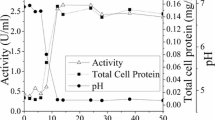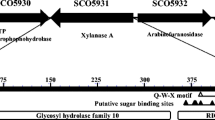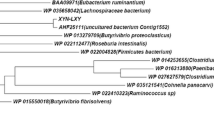Abstract
A xylanase gene, xynBS27, was cloned from Streptomyces sp. S27 and consisted of 693 bp encoding a 230-residue protein, including a putative 41-residue signal peptide. Belonging to the glycoside hydrolase family 11, XynBS27 exhibits the maximum identity (75.9%) to the xylanase from Streptomyces sp. zxy19. Recombinant XynBS27 was overexpressed in Pichia pastoris, and the xylanase activity was 7624.0 U/ml after high-cell-density fermentation in 3.7-L fermenter. The purified recombinant XynBS27 had a high specific activity of 3272.0 U/mg. The optimum temperature and pH for XynBS27 activity was 65 °C and pH 6.5, respectively. XynBS27 showed good pH stability and retained more than 80% of the maximum activity after incubation in buffers with pH ranging between 4.0 and 12.0 at 37 °C for 1 h. The main hydrolysis product of xylan by XynBS27 was xylobiose (>75%), which was good for human health derived from its ability to modulate the intestinal function. The attractive biochemical characteristics of XynBS27 suggest that it may be a good candidate in a variety of industrial applications.




Similar content being viewed by others
References
Collins, T., Gerday, C., & Feller, G. (2005). FEMS Microbiology Reviews, 29, 3–23. doi:10.1016/j.femsre.2004.06.005.
Biely, P. (1985). Trends in Biotechnology, 3, 286–290. doi:10.1016/0167-7799(85)90004-6.
Moure, A., Gullon, P., Dominguez, H., & Parajo, J. C. (2006). Process Biochemistry, 41, 1913–1923. doi:10.1016/j.procbio.2006.05.011.
Prade, R. A. (1996). Biotechnology & Genetic Engineering Reviews, 13, 101–131.
Kluepfel, D., Shareck, F., Mondou, F., & Morosoli, R. (1986). Applied Microbiology and Biotechnology, 24, 230–234. doi:10.1007/BF00261542.
Srivastava, R., Ali, S. S., & Srivastava, B. S. (1991). FEMS Microbiology Letters, 78, 201–206. doi:10.1016/0378-1097(91)90158-7.
Wang, Y. R., Zhang, H. L., He, Y. Z., Luo, H. Y., & Yao, B. (2007). Aquaculture (Amsterdam, Netherlands), 267, 328–334. doi:10.1016/j.aquaculture.2007.03.005.
Cheng, H. L., Wang, P. M., Chen, Y. C., Yang, S. S., & Chen, Y. C. (2008). Bioresource Technology, 99, 227–231. doi:10.1016/j.biortech.2006.11.023.
Ninawe, S., Kapoor, M., & Kuhad, R. C. (2008). Bioresource Technology, 99, 1252–1258. doi:10.1016/j.biortech.2007.02.016.
Li, N., Yang, P., Wang, Y., Luo, H., Meng, K., Wu, N., et al. (2008). Journal of Microbiology and Biotechnology, 18, 410–416.
Miller, G. L., Blum, R., Glennon, W. E., & Burton, A. L. (1960). Analytical Biochemistry, 2, 127–132. doi:10.1016/0003-2697(60)90004-X.
Chen, C. C., Wu, P. H., Huang, C. T., & Cheng, K. J. (2004). Enzyme and Microbial Technology, 35, 315–320. doi:10.1016/j.enzmictec.2004.05.007.
Yang, P., Shi, P., Wang, Y., Bai, Y., Meng, K., Luo, H., et al. (2007). Journal of Microbiology and Biotechnology, 17, 58–66.
Sanglier, J. J., Haag, H., Huck, T. A., & Fehr, T. (1993). Research in Microbiology, 144, 633–642. doi:10.1016/0923-2508(93)90066-B.
Georis, J., Giannotta, F., Lamotte-Brasseur, J., Devreese, B., Beeumen, J. V., Granier, B., et al. (1999). Gene, 237, 123–133. doi:10.1016/S0378-1119(99)00311-X.
Cereghino, J. L., & Cregg, J. M. (2002). FEMS Microbiology Reviews, 24, 45–66. doi:10.1111/j.1574-6976.2000.tb00532.x.
Böer, E., Steinborn, G., Kunze, G., & Gellissen, G. (2007). Applied Microbiology and Biotechnology, 77, 513–523. doi:10.1007/s00253-007-1209-0.
Kimura, T., Ito, J., Kawano, A., Makino, T., Kondo, H., Karita, S., et al. (2000). Bioscience, Biotechnology, and Biochemistry, 64, 1230–1237. doi:10.1271/bbb.64.1230.
Tsujibo, H., Miyamoto, K., Kuda, T., Minami, K., Sakamoto, T., Hasegawa, T., et al. (1992). Applied and Environmental Microbiology, 58, 371–375.
Kluepfel, D., Vats-Mehta, S., Aumont, F., Shareck, F., & Morosoli, R. (1990). The Biochemical Journal, 267, 45–50.
Zhang, G. M., Huang, J., Huang, G. R., Ma, L. X., & Zhang, X. E. (2007). Applied Microbiology and Biotechnology, 74, 339–346. doi:10.1007/s00253-006-0648-3.
Heck, J. X., Flôres, S. H., Hertz, P. F., & Ayub, M. A. (2006). Bioresource Technology, 97, 1902–1906. doi:10.1016/j.biortech.2005.08.013.
Li, N., Meng, K., Wang, Y., Shi, P., Luo, H., Bai, Y., et al. (2008). Applied Microbiology and Biotechnology, 80, 231–240. doi:10.1007/s00253-008-1533-z.
Ali, M. K., Fukumura, M., Sakano, K., Karita, S., Kimura, T., Sakka, K., et al. (1999). Bioscience, Biotechnology, and Biochemistry, 63, 1596–1604. doi:10.1271/bbb.63.1596.
Jiang, Z. Q., Deng, W., Zhu, Y. P., Li, L. T., Sheng, Y. J., & Hayashi, K. (2004). Journal of Molecular Catalysis. B, Enzymatic, 27, 207–213. doi:10.1016/j.molcatb.2003.11.012.
Jeong, K. J., Park, I. Y., Kim, M. S., & Kim, S. C. (1998). Applied Microbiology and Biotechnology, 50, 113–118. doi:10.1007/s002530051264.
Vazquez, M. J., Alonso, J. L., Dominguez, H., & Parajo, J. C. (2000). Trends in Food Science & Technology, 11, 387–393. doi:10.1016/S0924-2244(01)00031-0.
Chen, C. S., Chen, J. L., & Lin, T. Y. (1997). Enzyme and Microbial Technology, 21, 91–96. doi:10.1016/S0141-0229(96)00236-0.
Acknowledgments
This work was supported by National High Technology Research and Development Program of China (863 Program; no. 2007AA100601) and National Key Technology R&D Program of China (no. 2006BAD12B05-03).
Author information
Authors and Affiliations
Corresponding author
Rights and permissions
About this article
Cite this article
Li, N., Shi, P., Yang, P. et al. Cloning, Expression, and Characterization of a New Streptomyces sp. S27 Xylanase for Which Xylobiose is the Main Hydrolysis Product. Appl Biochem Biotechnol 159, 521–531 (2009). https://doi.org/10.1007/s12010-008-8411-0
Received:
Accepted:
Published:
Issue Date:
DOI: https://doi.org/10.1007/s12010-008-8411-0




